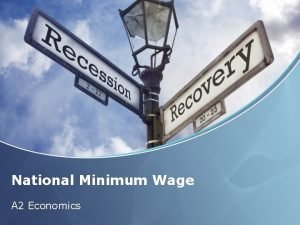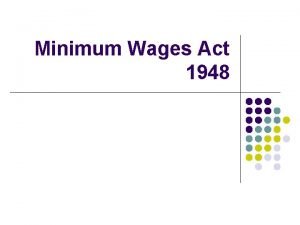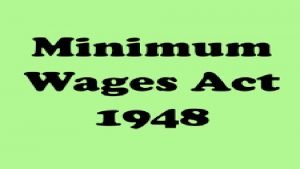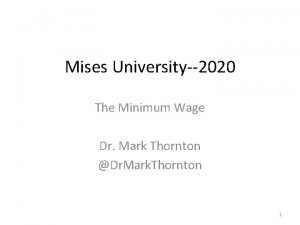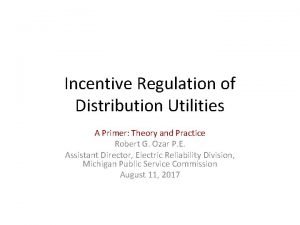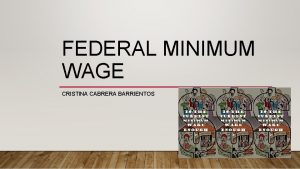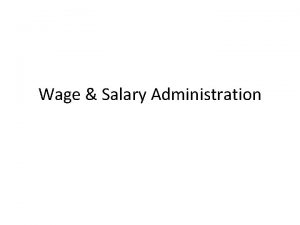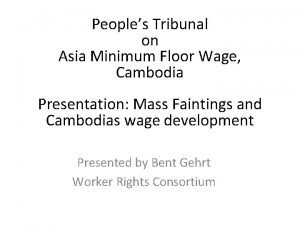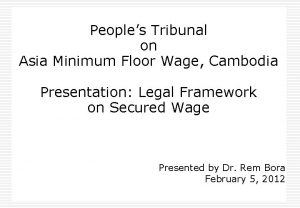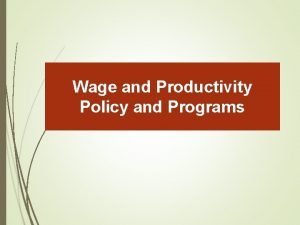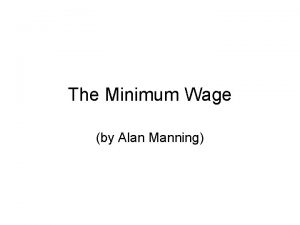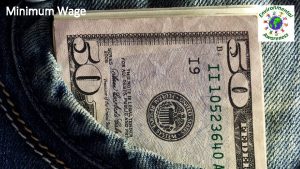Chapter 26 Presentations 2 Minimum Wage Wage Floor




















- Slides: 20

Chapter 26 Presentations 2

Minimum Wage • “Wage Floor” set to help less skilled workers earn enough money to escape poverty

2012 Ohio Minimum Wage • $7. 70 per hour for non-tipped employees • $3. 85 per hour for tipped employees (plus tips) • The Federal Wage is $7. 25 per hour

Criticism of Minimum Wage • Higher wages often force employers to cut back and the low wage workers that the minimum wage was designed to help find themselves out of work • Poorly targeted- many of the jobs go to teenagers instead of individuals in poverty

Pro Minimum Wage • Paying higher wages would increase productivity and thus justify the increase in pay • Higher pay would also keep turnover rates down in unskilled positions

Minimum Wage Graph

Poverty Levels • Persons in family/household • • 1 2 3 4 5 6 7 8 Income Level $11, 170 15, 130 19, 090 23, 050 27, 010 30, 970 34, 930 38, 890

Wage Differentials • The difference between the wage received by one worker or group of workers and that received by another worker or group of workers • Ex- 1 st year news anchor v. experienced anchor

Compensating Differences • Differences in the wages received by workers in different jobs to compensate for nonmonetary differences in jobs • Ex- construction workers often make more than sales clerks due to the physical rigors and seasonal employment of construction

Human Capital • Personal stock of knowledge and skills that enables a person to be productive and thus to earn income

Barriers to Higher Wages • • 1. lack of job information 2. geographic immobility 3. union and government restrictions 4. Discrimination

Incentive Pay Plans • Ties worker compensation directly to performance

Ways to fight Ineffective Workers. Incentive Pay • 1. Piece Rates- pay per # output • 2. Commission or Royalties- based on value of sales • 3. Bonuses, Stock Options and Profit Sharing • 4. Efficiency Wages- pay above equilibrium wages

Are You Kidding Me? • • • 5 Highest Paid CEOs, 2011 (in millions) 1. Lawrence Ellison, Oracle ($56. 8) 2. Carol Bartz, Yahoo ($47. 2) 3. Leslie Moonves, CBS Corp ($43. 2) 4. Marc Casper, Thermo Fisher ($34. 3) 5. John Hammergren, Mc. Kesson ($34. 2)

Labor Unions • These organizations have many goals including improved working conditions, hours, etc • ***Main objective is to increase wages*** • There are 3 union models in which they attempt to obtain better wages

1. Demand Enhancement Model • From a union viewpoint, the best way to raise wages is to increase the demand for labor • This increase in labor demand will create higher wages and more jobs • 3 ways this can occur: – A. Increase Product Demand (advertising) – B. Increase Productivity ( – C. Alter the Price of Other Inputs (reduce tariffs on complementary goods or increase on substitutes)

• Demand Enhancement Model Wage Rate (Dollars) – Increase Product Demand – Increase Productivity – Alter the Price of Other Inputs S Increase In Demand Wu Wc D 2 D 1 Qc Qu Quantity of Labor

2. Exclusive Union (Craft Union) • Reduce the supply of labor to raise wages • Occupational Licensing that requires certain training to be part of the union • Ex- American Medical Association, American Bar Association

3. Inclusive Union (Industrial Union) • Try to make all available labor in an industry part of a union- skilled and unskilled workers • Strengthens the threat of a strike so companies are much more likely to give higher wages

Bilateral Monopoly • A monopoly v. a Monopsony • 1 supplier of labor (union) and 1 company hiring (monopoly)
 Croatia minimum wage
Croatia minimum wage Minimum wage argument
Minimum wage argument The minimum wages act 1948
The minimum wages act 1948 Minimum wage romania
Minimum wage romania The minimum wage act 1948
The minimum wage act 1948 Minimum wage essay outline
Minimum wage essay outline Minimum wage
Minimum wage Slovakia quiz
Slovakia quiz Liberals vs conservatives minimum wage
Liberals vs conservatives minimum wage Explain how does rentals affect filipino entrepreneurs
Explain how does rentals affect filipino entrepreneurs Disadvantage of raising minimum wage
Disadvantage of raising minimum wage Absolute maxima and local maxima
Absolute maxima and local maxima The craft of scientific presentations
The craft of scientific presentations Introduction to mental health awareness presentation
Introduction to mental health awareness presentation Awful powerpoint presentations
Awful powerpoint presentations To maintain audience interest in a multimedia presentation
To maintain audience interest in a multimedia presentation Slidetodoc.com
Slidetodoc.com Corel presentations ventajas
Corel presentations ventajas Designing and delivering oral and online presentations
Designing and delivering oral and online presentations Example of verbal support
Example of verbal support How to make a tok presentation
How to make a tok presentation

